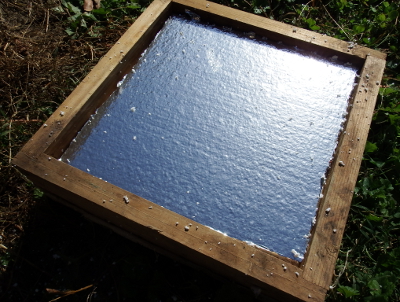
Modifying the Warre quilt

When I first read about Warre hives, the quilt box
was perhaps my favorite part. It simply made so much sense ---
insulating the hive from summer heat and winter cold while also soaking
up moisture from dehydrating nectar.
Unfortunately, in
practice, the quilt box has given me a neverending string of trouble.
First of all, there's the fact that in our humid climate, I'd have to
change the straw every week if I wanted it to actually sop up the hive's
moisture. Then there's the fact that ants like to live up in the quilt and raid honey from the bees below.
Meanwhile, our bees don't
seem to like the quilt box either. When I used the fabric- or
burlap-lined quilt boxes that came with our hive, the bees gnawed right
through. Then when I converted over to moderately impenetrable window
screening, the bees instead propolized the entire screen...and glued it
to the frames below for the sake of completeness. That was a hard top  to pry off!
to pry off!
So I'm changing gears yet
again, filling the quilt box with layers of styrofoam this time around.
I'm hoping the synthetic material will insulate the hive without
providing such an ant-friendly habitat. And, if the insulation works,
I'll probably put a solid wooden bottom on the quilt box as well.
Perhaps Langstroth knew what he was doing after all....
Want more in-depth information? Browse through our books.
Or explore more posts by date or by subject.
About us: Anna Hess and Mark Hamilton spent over a decade living self-sufficiently in the mountains of Virginia before moving north to start over from scratch in the foothills of Ohio. They've experimented with permaculture, no-till gardening, trailersteading, home-based microbusinesses and much more, writing about their adventures in both blogs and books.
Want to be notified when new comments are posted on this page? Click on the RSS button after you add a comment to subscribe to the comment feed, or simply check the box beside "email replies to me" while writing your comment.

Ugh, I completely sympathize with your quilt box troubles. Earlier this year I had a really bad infestation of carpenter ants that weakened one hive enough to kill it. I've since put cinnamon in the box, which seems to keep the ants out.
Interesting about the window screen, because I was thinking of trying that as well. Did they seal it off so much that it blocked airflow?
My old beekeeping club in Minnesota used to recommend some fiberboard type stuff called Bildrite for a winter-time moisture wick. Not sure how it would do for year-round use. [Here]http://www.tc.umn.edu/~reute001/htm-files/Moisture%20board.html is one of the guys' sites about ideas for winter moisture quilts.
I think they recommend against styrofoam because it doesn't let air through (and doesn't absorb moisture, but it sounds like that might be ok for you, at least in the humid summer months).